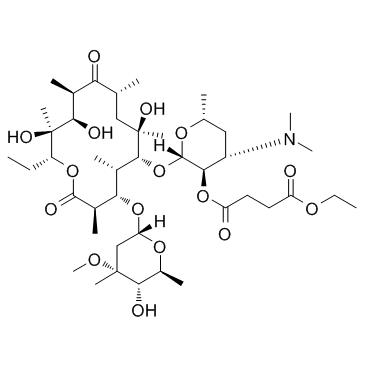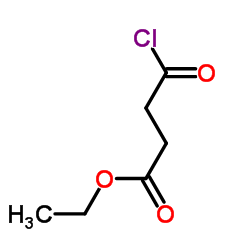Erythromycin Ethylsuccinate

Erythromycin Ethylsuccinate structure
|
Common Name | Erythromycin Ethylsuccinate | ||
|---|---|---|---|---|
| CAS Number | 1264-62-6 | Molecular Weight | 862.053 | |
| Density | 1.2±0.1 g/cm3 | Boiling Point | 874.1±65.0 °C at 760 mmHg | |
| Molecular Formula | C43H75NO16 | Melting Point | 219-224ºC | |
| MSDS | Chinese USA | Flash Point | 482.4±34.3 °C | |
| Symbol |

GHS08 |
Signal Word | Danger | |
Use of Erythromycin EthylsuccinateErythromycin Ethylsuccinate is an antibiotic useful for the treatment of a number of bacterial infections, has an antimicrobial spectrum similar to or slightly wider than that of penicillin. |
| Name | Erythromycin ethyl succinate |
|---|---|
| Synonym | More Synonyms |
| Description | Erythromycin Ethylsuccinate is an antibiotic useful for the treatment of a number of bacterial infections, has an antimicrobial spectrum similar to or slightly wider than that of penicillin. |
|---|---|
| Related Catalog |
| Density | 1.2±0.1 g/cm3 |
|---|---|
| Boiling Point | 874.1±65.0 °C at 760 mmHg |
| Melting Point | 219-224ºC |
| Molecular Formula | C43H75NO16 |
| Molecular Weight | 862.053 |
| Flash Point | 482.4±34.3 °C |
| Exact Mass | 861.508606 |
| PSA | 226.28000 |
| LogP | 4.10 |
| Vapour Pressure | 0.0±0.6 mmHg at 25°C |
| Index of Refraction | 1.529 |
| Storage condition | 2-8°C |
| Water Solubility | ethanol: soluble50mg/mL | Freely soluble in organic solvents, practically insoluble in water |
|
Section 1. Chemical Product and Company Identification Erythromycin ethylsuccinateCatalog Common Name/ Number(s). Trade Name CAS#C43H75NO16 Manufacturer
RTECSWM9800000 SPECTRUM CHEMICAL MFG. CORP. TSCATSCA 8(b) inventory: No products were found. Commercial Name(s)Not available. CI# Not available. SynonymErythromycin 2'-(ethyl butanedioate) IN CASE OF EMERGENCY Not available. Chemical Name Chemical FamilyNot available.CALL (310) 516-8000 Not available. Chemical Formula SPECTRUM CHEMICAL MFG. CORP. Section 2.Composition and Information on Ingredients Exposure Limits TWA (mg/m3)STEL (mg/m3) CEIL (mg/m3) NameCAS #% by Weight 1) Erythromycin ethylsuccinateC43H75NO16100 Toxicological DataErythromycin ethylsuccinate: on IngredientsORAL (LD50):Acute: >5000 mg/kg [Mouse]. Section 3. Hazards Identification Potential Acute Health Effects Hazardous in case of skin contact (irritant), of eye contact (irritant), of ingestion, of inhalation (lung irritant). Slightly hazardous in case of skin contact (permeator). Potential Chronic HealthCARCINOGENIC EFFECTS: Not available. MUTAGENIC EFFECTS: Not available. Effects TERATOGENIC EFFECTS: Not available. DEVELOPMENTAL TOXICITY: Not available. Repeated or prolonged exposure is not known to aggravate medical condition. Erythromycin ethylsuccinate Section 4. First Aid Measures Eye ContactCheck for and remove any contact lenses. Immediately flush eyes with running water for at least 15 minutes, keeping eyelids open. Cold water may be used. Do not use an eye ointment. Seek medical attention. Skin ContactAfter contact with skin, wash immediately with plenty of water. Gently and thoroughly wash the contaminated skin with running water and non-abrasive soap. Be particularly careful to clean folds, crevices, creases and groin. Cover the irritated skin with an emollient. If irritation persists, seek medical attention. Wash contaminated clothing before reusing. Serious Skin ContactWash with a disinfectant soap and cover the contaminated skin with an anti-bacterial cream. Seek medical attention. InhalationAllow the victim to rest in a well ventilated area. Seek immediate medical attention. Serious InhalationNot available. IngestionDo not induce vomiting. Loosen tight clothing such as a collar, tie, belt or waistband. If the victim is not breathing, perform mouth-to-mouth resuscitation. Seek immediate medical attention. Serious IngestionNot available. Section 5. Fire and Explosion Data Flammability of the Product May be combustible at high temperature. Auto-Ignition Temperature Not available. Flash PointsNot available. Flammable LimitsNot available. Not available. Products of Combustion Fire Hazards in Presence of Not available. Various Substances Explosion Hazards in Presence Risks of explosion of the product in presence of mechanical impact: Not available. of Various SubstancesRisks of explosion of the product in presence of static discharge: Not available. Fire Fighting MediaSMALL FIRE: Use DRY chemical powder. and InstructionsLARGE FIRE: Use water spray, fog or foam. Do not use water jet. Special Remarks onNot available. Fire Hazards Special Remarks on Explosion Not available. Hazards Section 6. Accidental Release Measures Small SpillUse appropriate tools to put the spilled solid in a convenient waste disposal container. Finish cleaning by spreading water on the contaminated surface and dispose of according to local and regional authority requirements. Large Spill Use a shovel to put the material into a convenient waste disposal container. Finish cleaning by spreading water on the contaminated surface and allow to evacuate through the sanitary system. Erythromycin ethylsuccinate Section 7. Handling and Storage PrecautionsKeep away from heat. Keep away from sources of ignition. Empty containers pose a fire risk, evaporate the residue under a fume hood. Ground all equipment containing material. Do not ingest. Do not breathe dust. Wear suitable protective clothing In case of insufficient ventilation, wear suitable respiratory equipment If ingested, seek medical advice immediately and show the container or the label. Avoid contact with skin and eyes StorageKeep container dry. Keep in a cool place. Ground all equipment containing material. Keep container tightly closed. Keep in a cool, well-ventilated place. Combustible materials should be stored away from extreme heat and away from strong oxidizing agents. Section 8. Exposure Controls/Personal Protection Engineering ControlsUse process enclosures, local exhaust ventilation, or other engineering controls to keep airborne levels below recommended exposure limits. If user operations generate dust, fume or mist, use ventilation to keep exposure to airborne contaminants below the exposure limit. Personal ProtectionSplash goggles. Lab coat. Dust respirator. Be sure to use an approved/certified respirator or equivalent. Gloves. Personal Protection in Case of Splash goggles. Full suit. Dust respirator. Boots. Gloves. A self contained breathing apparatus should be used a Large Spillto avoid inhalation of the product. Suggested protective clothing might not be sufficient; consult a specialist BEFORE handling this product. Exposure LimitsNot available. Section 9. Physical and Chemical Properties Physical state and appearance Solid. (Crystalline solid.)OdorNot available. TasteNot available. 862.07 g/mole Molecular Weight ColorWhite to yellowish. pH (1% soln/water)Not available. Boiling PointNot available. Melting PointNot available. Critical TemperatureNot available. Specific GravityNot available. Not applicable. Vapor Pressure Vapor DensityNot available. VolatilityNot available. Odor ThresholdNot available. Water/Oil Dist. Coeff.Not available. Not available. Ionicity (in Water) Dispersion PropertiesNot available. Very slightly soluble in cold water. Solubility Section 10. Stability and Reactivity Data The product is stable. Stability Instability TemperatureNot available. Not available. Conditions of Instability Incompatibility with various Not available. substances Erythromycin ethylsuccinate CorrosivityNon-corrosive in presence of glass. Special Remarks onNot available. Reactivity Special Remarks onNot available. Corrosivity PolymerizationNo. Section 11. Toxicological Information Routes of EntryEye contact. Inhalation. Ingestion. Toxicity to AnimalsAcute oral toxicity (LD50): >5000 mg/kg [Mouse]. Chronic Effects on Humans Not available. Other Toxic Effects onHazardous in case of skin contact (irritant), of ingestion, of inhalation (lung irritant). HumansSlightly hazardous in case of skin contact (permeator). Special Remarks onNot available. Toxicity to Animals Special Remarks onNot available. Chronic Effects on Humans Special Remarks on otherNot available. Toxic Effects on Humans Section 12. Ecological Information EcotoxicityNot available. BOD5 and CODNot available. Products of BiodegradationPossibly hazardous short term degradation products are not likely. However, long term degradation products may arise. Toxicity of the ProductsThe products of degradation are more toxic. of Biodegradation Special Remarks on theNot available. Products of Biodegradation Section 13. Disposal Considerations Waste Disposal Section 14. Transport Information DOT ClassificationNot a DOT controlled material (United States). IdentificationNot applicable. Special Provisions forNot applicable. Transport Erythromycin ethylsuccinate DOT (Pictograms) Section 15. Other Regulatory Information and Pictograms TSCA 8(b) inventory: No products were found. Federal and State Regulations California Proposition 65 Warnings Other RegulationsEINECS: This product is on the European Inventory of Existing Commercial Chemical Substances. WHMIS (Canada) Not controlled under WHMIS (Canada). Other Classifications DSCL (EEC)R36/37/38- Irritating to eyes, respiratory system and skin. Health Hazard HMIS (U.S.A.)2 National Fire Protection 1 Flammability 1 Association (U.S.A.) Fire Hazard 2 0 Reactivity Health Reactivity 0 Specific hazard Personal Protection E WHMIS (Canada) (Pictograms) DSCL (Europe) (Pictograms) TDG (Canada) (Pictograms) ADR (Europe) (Pictograms) Protective Equipment Gloves. Lab coat. Dust respirator. Be sure to use an approved/certified respirator or equivalent. Erythromycin ethylsuccinate SECTION 16 - ADDITIONAL INFORMATION N/A |
CHEMICAL IDENTIFICATION
HEALTH HAZARD DATAACUTE TOXICITY DATA
|
| Symbol |

GHS08 |
|---|---|
| Signal Word | Danger |
| Hazard Statements | H317-H334 |
| Precautionary Statements | P261-P280-P284-P304 + P340-P342 + P311 |
| Personal Protective Equipment | dust mask type N95 (US);Eyeshields;Faceshields;Gloves |
| Hazard Codes | Xn:Harmful |
| Risk Phrases | R42/43 |
| Safety Phrases | S36 |
| RIDADR | NONH for all modes of transport |
| WGK Germany | 2 |
| RTECS | WM9800000 |
| HS Code | 2941500000 |
|
~% 
Erythromycin Et... CAS#:1264-62-6 |
| Literature: Antibiotics Chemotherapy, , vol. 7, p. 487 |
| Precursor 2 | |
|---|---|
| DownStream 0 | |
| HS Code | 2941500000 |
|---|
|
Hapten synthesis, monoclonal antibody production and development of a competitive indirect enzyme-linked immunosorbent assay for erythromycin in milk.
Food Chem. 171 , 98-107, (2014) Erythromycin is an antibiotic used extensively in veterinary practice worldwide for treatment, prevention and growth promotion. In this work, monoclonal antibodies (Mabs) against erythromycin were pro... |
|
|
Sensitive determination of tilmicosin, erythromycin ethylsuccinate and clindamycin by CE with electrochemiluminescence detection using azithromycin as internal standard and its applications.
J. Sep. Sci. 33(9) , 1305-11, (2010) A sensitive approach for the simultaneous determination of tilmicosin, erythromycin ethylsuccinate and clindamycin was developed by CE coupled with electrochemiluminescence detection with ionic liquid... |
|
|
Pharmacokinetics of erythromycin after the administration of intravenous and various oral dosage forms to dogs.
J. Vet. Pharmacol. Ther. 31(6) , 496-500, (2008) The purpose of this study was to describe and compare the pharmacokinetic properties of different formulations of erythromycin in dogs. Erythromycin was administered as lactobionate (10 mg/kg, IV), es... |
| ERYTHROMYCIN ETHYISUCCINATE |
| ERYTHROCINETHYLSUCCINATE |
| ErythromycinEthylsuccinate |
| Erythromycin ethylsuccinate |
| ERYTHROMYCIN ETHYL SUCCINATE |
| ERYTHROMYCIN ETHYLSUCCINATE API |
| (2S,3R,4S,6R)-4-(Dimethylamino)-2-{[(3S,4R,5R,6S,7S,9S,11S,12S,13R,14S)-14-ethyl-7,12,13-trihydroxy-4-{[(2R,4R,5S,6S)-5-hydroxy-4-methoxy-4,6-dimethyltetrahydro-2H-pyran-2-yl]oxy}-3,5,7,9,11,13-hexamethyl-2,10-dioxooxacyclotetradecan-6-yl]oxy}-6-methyltetrahydro-2H-pyran-3-yl ethyl succinate |
| ERYTHROMYCIN ETHYLSUCCINATE, ANTIBIOTIC FOR CULTURE MEDIA USE ONLY |



